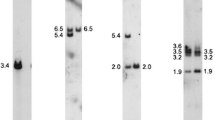Summary
Using 32P-labeled probe consisting mainly of (GATA)n we have shown that a male specific Alu1 DNA blot pattern which defines the Y chromosome sex-determining locus in inbred mice is highly polymorphic in wild mice, indicating substantial sequence evolution in this region under field conditions. In all cases examined by in situ hybridization, the region concerned is paracentromeric. In contrast, the blot pattern of another probe (M 34) which detects repeated sequences specific to the mouse Y chromosome but outside the sex-determining locus, remains constant between different isolates.
Similar content being viewed by others
References
Bishop CE, Boursot P, Baron B, Bonhomme F, Hatat D (1985) Most classical Mus musculus domesticus laboratory mouse strains carry a Mus musculus musculus Y chromosome. Nature 315:70–72
Bittner M, Kupferer P, Morris CF (1980) Electrophoretic transfer of proteins and nucleic acids from slab gels to diazobenzyloxymethyl cellulose or nitrocellulose sheets. Anal Biochem 102:459–471
Bonhomme F, Catalan J, Britton-Davidian J, Chapman VM, Moriwaki K, Nevo E, Thaler L (1984) Biochemical diversity and evolution in the genus Mus. Biochem Genet 22:275–303
Cooke HJ, Brown WRA, Rappold GA (1985) Hypervariable telomeric sequences from the human sex chromosomes are pseudoautosomal. Nature 317:687–692
Coyne JA (1985) The genetic basis of Haldane's rule. Nature 314:736–738
Eicher EM, Washburn LL, Whitney JB, Morrow KE (1982) Mus poschiavinus Y chromosome in the C57BL/6J murine genome causes sex reversal. Science 217:535–537
Forejt J (1981) Hybrid sterility gene located in the T/t-H-2-supergene on chromosome 17. In: Retsfeld RA, Ferrone S (eds) Current Trends in Histocompatibility, vol 1. Plenum Press, New York, pp 103–131
Forejt J, Ivanyi P (1975) Genetic studies of male sterility of hybrids between laboratory and wild mice. Genet Res 24:189–206
Gropp A, Winking H (1983) XY sex reversal in mice. Genet Res 41:314
Gropp A, Winking H, Redi C, Capanna E, Britton-Davidian J, Noack G (1982) Robertsonian karyotype variation in wild house mice from Rhaeto-Lombardia. Cytogenet Cell Genet 34:67–77
Harbers K, Soriano P, Muller U, Jaenisch R (1986) High frequency of unequal recombination in pseudoautosomal region shown by proviral insertion in transgenic mouse. Nature 324:682–685
Hu N, Messing J (1982) The making of strand-specific M13 probes. Gene 17:271–277
Jones KW, Singh L (1981a) Conserved sex-associated repeated DNA in vertebrates. In: Dover G, Flavell R (eds) Genome Evolution. Academic Press, London, pp 135–154
Jones KW, Singh L (1981b) Conserved repeated DNA sequences in vertebrate sex chromosomes. Hum Genet 58:46–53
Jones KW, Olszewska E, Singh L (1987) Rapidly evolving Bkm DNA is associated with hypervariable domains. In: Stahl A, Luciani JM, Vagner-Capodano AM (eds) Chromosomes Today, vol 9. Allen and Unwin, Suffolk, England, pp 22–29
Kiel-Metzger K, Erickson RP (1984) Regional localization of sex-related sequences on proximal chromosome 17 of mice. Nature 310:579–581
Lamar E, Palmer E (1984) Y encoded, species-specific DNA in mice: Evidence that the Y chromosome exists in two polymorphic forms in inbred strains. Cell 37:171–177
Livak KJ (1984) Organization and mapping of a sequence on the Drosophila melanogaster X and Y chromosomes that is transcribed during spermatogenesis. Genetics 107:611–634
Marshall JT, Sage RD (1981) Taxonomy of the house mouse. Symp Zool Soc Lond 47:15–25
Matsukuma S, Singh L, Jones KW (1987) Microinjection of Bkm related male specific mouse DNA into autologous zygotes. J Genet 66:163–176
Melton DA, Kreig PA, Rebaglianti MR, Maniatis T, Zinn K, Green MR (1984) Efficient in vitro synthesis of biologically active RNA and RNA hybridization probes from plasmids containing a bacteriophage SP6 promoter. Nucleic Acids Res 12:7035–7056
Nishioka Y (1987) Y-chromosomal DNA polymorphism in mouse inbred strains. Genet Res 50:69–72
Sage RD (1981) Wild mice. In: Foster HL, Small JD, Fox JG (eds) The mouse in Biomedical Research, vol 1. Academic Press, New York, pp 39–90
Schwarz E, Schwarz HK (1943) The wild and commensal stocks of the house mouse Mus musculus Linnaeus. J Mammal 24:59–72
Singh L, Jones KW (1982) Sex reversal in the mouse (Mus musculus) is caused by a recurrent non-reciprocal crossover involving the X and an aberrant Y chromosome. Cell 28:205–216
Singh L, Jones KW (1984) The use of heparin as a simple costeffective means of controlling background in nucleic acid hybridization procedures. Nucleic Acids Res 12:5627–5638
Singh L, Jones KW (1986) Bkm sequences are polymorphic in humans and are clustered in pericentric regions of various acrocentric chromosomes including the Y. Hum Gent 73:304–308
Singh L, Purdom IF, Jones KW (1981) Conserved sex chromosome-associated nucleotide sequences in eukaryotes. Cold Spring Harbor Symp Quant Biol 45:805–813
Singh L, Phillips C, Jones KW (1984) The conserved nucleotide sequences of Bkm which define Sxr in the mouse are transcribed. Cell 36:111–120
Southern EM (1975) Detection of specific sequences amongst DNA fragments separated by gel electrophoresis. J Mol Biol 98:503–517
Thaler L, Bonhomme F, Britton-Davidian J (1981) Processes of speciation and semi-speciation in the house mouse. Sympt Zool Soc Lond 47:27–41
Traut W (1987) Hypervariable Bkm DNA loci in a moth, Ephestia kuechniella: Does transposition cause restriction fragment length polymorphism (RFLP)? Genetics 115:493–498
Wahl GM, Stern M, Stark GR (1979) Efficient transfer of large DNA fragments from agarose gels to diazobenzyloxymethyl paper and rapid hybridization by using dextran sulfate. Proc Natl Acad Sci USA 76:3683–3687
Washburn LL, Eicher EM (1983) Sex reversal in XY mice caused by dominant mutation on chromosome 17. Nature 303:338–340
Author information
Authors and Affiliations
Additional information
Communicated by E.K.F. Bautz
Deceased
Rights and permissions
About this article
Cite this article
Singh, L., Winking, H., Jones, K.W. et al. Restriction fragment polymorphism in the sex-determining region of the Y chromosomal DNA of European wild mice. Mol Gen Genet 212, 440–449 (1988). https://doi.org/10.1007/BF00330848
Received:
Issue Date:
DOI: https://doi.org/10.1007/BF00330848




